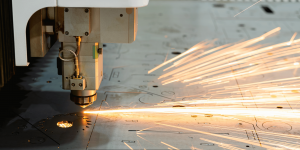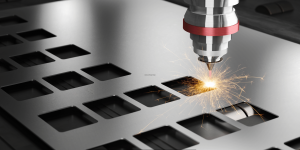Introduction to Laser Processing
Laser treatment includes a number of operations in which laser beams are used to remove material and join or treat the material in some way. Lasers produce intense, highly collimated light that can transfer large amounts of power to a small area, which is ideal for cutting, welding, drilling, marking, and heat treating.
Some of the most common laser processing techniques include:
– Laser Cutting
– Laser Welding
– Laser Drilling
– Laser Marking
– Laser Heat Treating
Laser Cutting
Laser cutting employs a laser beam that is used to vaporize material to create such characteristics as patterns and geometries.
Some benefits of laser cutting include:
– High precision – Laser can cut images with a thickness of up to 0. 001 inches. This allows the creation of complex two-dimensional and three-dimensional shapes.
– Low debris generation – Laser cutting is very clean, and only a tiny amount of the material is ejected as a plume. The cut edge requires very little dressing up.
– Versatile – Lasers can be used in fabrics and other soft materials, as well as metals and ceramics.
It is used to cut metal parts for aerospace, automotive, and even medical fields. It is also used in cutting of fabrics, wood, plastics, and many things that are made from these stuffs. There are two conventional laser cutting processes: fusion cutting, where the laser melts the material, and flame cutting, where the laser makes the material burn.

Laser Welding
Laser welding is a process where heat and energy in the form of a laser are used to fuse the metals or thermoplastics.
Compared to traditional welding methods, laser welding provides these advantages:
– Less Heat – The light is focused and hence the heat generated is also focused less heat is produced.
– Faster Welding Rates – Laser welds are made faster than the usual welding processes.
– Better Seal Strengths and Resistance to Leakage – Laser welding minimizes porosity.
There are two main types of laser welding processes:
– Conduction Welding – The laser beam joins the surfaces to their welding temperature.
– Keyhole Welding – The laser spot melts a hole into the metals and vaporizes a hole more profound into the metals. This makes the edges of the hole come into contact with one another.
Laser welding is used in industries such as automotive, medical, electronics, and aerospace industries. It can join steel, aluminum, titanium, plastics, and many others. Usually, engineers know how to choose the proper welding techniques depending on the type of welding joints and base materials.
Laser Drilling
Laser drilling is a process that applies laser beams to drill small and accurate holes in materials such as metals, ceramics, composites, and diamonds. Compared to mechanical drilling, laser drilling offers benefits like:
– More Accurate – A laser drill can drill holes with a diameter of between 20-50 micrometers. Mechanical bits are limited to about 500 micrometers.
– Greater Length-to-Diameter Ratios – Laser beams can create holes with a more significant aspect ratio.
– Laser beam does not wear out – This is unlike the traditional drills where the drill bits wear out over a period of time due to frequent use.
Laser drilling is helpful in creating small fuel injection ports in automotive parts, cooling passages in turbine blades, and holes in circuit boards. The pulsed lasers melt the material to make deep holes in the workpiece. The unwanted material is expelled out of the hole using gas pressure in this case.
Laser Marking
Laser marking systems employ specific laser heads to produce, engrave, or heat treat various designs and letters into different materials.
Some advantages of laser marking are:
– Permanent Marking – They use lasers to engrave the material, forming permanent and unique identification codes, logos, and images.
– Speed – Laser heads mark faster compared to mechanical engraving or inkjet printing.
– Wide Applicability – Laser marking can be quickly done on metals, plastics, rubber, glass, wood, and many other materials.

Laser marking gives unique and serial numbers, logos, text, 2D barcodes, and Quick Response or QR codes. It is used in aerospace engineering, automobiles, electronics, medical technology, military technology, and packaging. Color change marking, heat treatment, cutting, and engraving are some of the methods that are frequently used in laser marking.
Laser Heat Treating
Laser heat treatment involves using a laser to selectively heat the materials in a specific pattern in order to harden or soften them.
Benefits include:
– Selective Coagulation – Lasers selectively target regions that require treatment without having to heat the whole of the component.
– Distortion Reduction – Since the furnace is localized, part warpage is minimized, unlike in the case of the regular heat treatment furnaces.
– Higher Hardness – Heat treatment by laser control of heating and cooling enhances and improves the hardness and wear properties.
Flash surface hardening is made possible through laser heat treatment and can be used on delicate and intricate parts. They write and deliver unique graded compositions. Some of the most frequent laser heat treatment processes are hardening, tempering, annealing, and surface coating.
Conclusion
Laser processing uses high-energy laser beams to perform operations such as cutting, welding, drilling, marking, engraving, and heat treatment on materials. Advanced laser manufacturing technologies help in the production of new designs and improved properties in various fields. Forthcoming developments in high-power industrial lasers and processing techniques will enhance the quality, capability, and productivity in the future.
